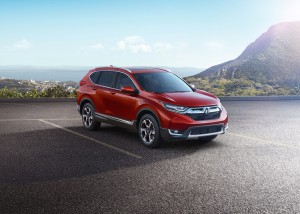Growing worldwide demand for sport- and crossover-utility vehicles helped Honda Motor Co. beat its own earnings forecast for the July to September quarter.
The third-largest Japanese automaker delivered a 177 billion yen, or $1.7 billion, profit, while Honda also upgraded its forecast for the full year by about 4%, to 415 billion yen, or nearly $4.
The upturn during the second quarter of the Japanese fiscal year was a welcome turnaround. During the April-June quarter Honda profits tumbled 6%, largely the result of the ongoing Takata airbag recalls. Honda is one of the largest customers of Takata, whose defective airbags have now been linked to at least 15 deaths worldwide.
About 100 million vehicles using those devices have been recalled worldwide, a disproportionate share by Honda. Just last week, arch-rival Toyota announced the recall of another 6 million Takata-equipped vehicles, underscoring the likelihood that the impact of the airbag problem will be felt by all of the supplier’s customers for some time to come.

Honda officials expect the new CR-V to overtake its perennial best-selling vehicles, the Civic and Accord, in the near future.
(Another death blamed on Takata airbag. Click Here for the latest update.)
On the positive side, Honda saw solid performance in several corners this past quarter. Demand for its new Civic family has been strong and growing as the maker has rolled out a series of new variants, including a sedan, a new Civic coupe and various hatchback versions. Several other Civic packages, including the high-performance Type-R are set to launch in the months ahead.
But Honda’s real surge has been in the utility-vehicle segment with global products such as the CR-V and, in China, models such as the XR-V and Vezel.
(Next-gen Honda CR-V expected to become brand’s US best-seller. Click Here for more.)
Growing demand for utility vehicles has helped boost the average transaction price for Honda vehicles.
Not everything went according to plan for Honda, however. Revenues slid 9.9% for the latest quarter, to 3.26 trillion yen, or $32.18 billion, even as retail sales surged 6.3%, to 2.43 million vehicles. Unfavorably currency exchange rates were a major factor in the revenue retrenchment.
Honda offset that, to a small degree, with cost-cutting efforts that saved it 55.3 billion yen, or $546 million.
One of the biggest factors behind Honda’s strong Q2 performance came in the form of a one-time windfall of nearly $1 billion as the company shifts its retirement age from 60 to 65 years of age. That let the company defer pension payments – and all but offset the $1.02 billion impact from exchange rate fluctuations.
The strengthening U.S. dollar hurt Honda’s North American operations, though the region – which has been running at a record sales pace – remained one of the automaker’s big manufacturing and sales centers.
At the other extreme, operating profits tumbled 97% in Europe, to a mere 105.0 million yen, or $1.04 million, down from 3.14 billion yen a year ago.
For the full year ending March 31, 2017, Honda is forecasting a 415 billion yen profit, or nearly $4 billion at current exchange rates, from the original estimate of 390 billion yen. The company also expects a 1.3% jump in worldwide sales, to 4.98 million vehicles. It originally had forecast sales of 4.92 million units.
(US new vehicles sales expected to dip in October as long-hot market cools. Click Here for the latest.)


